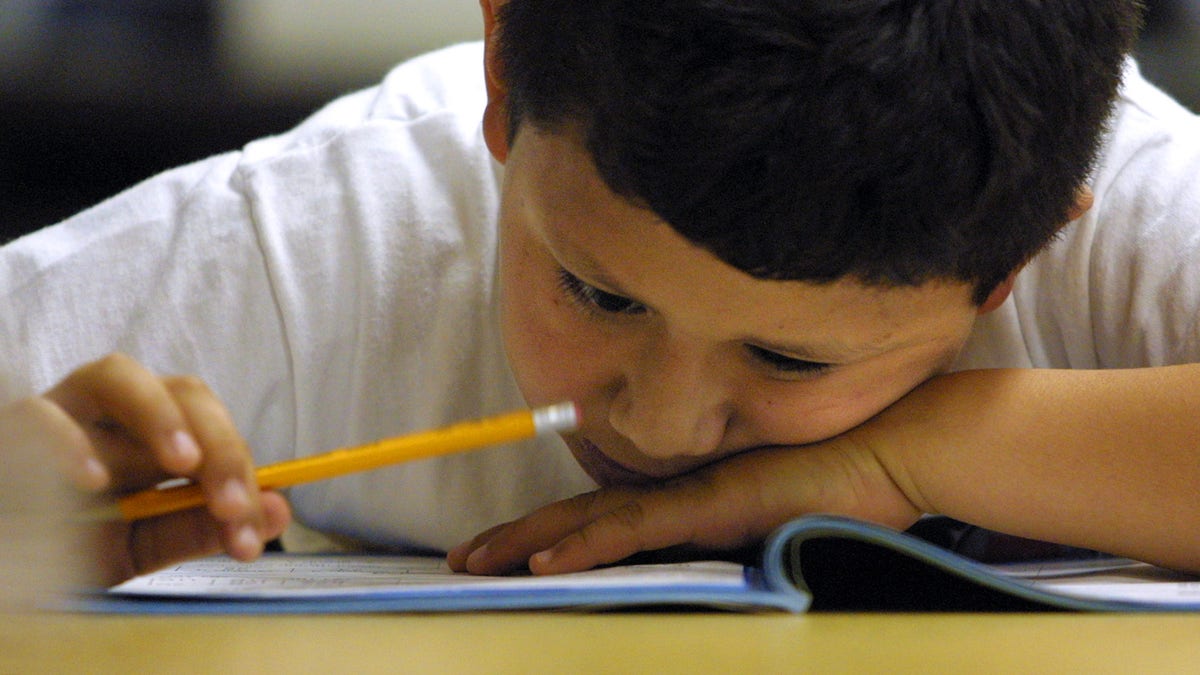
391429 06: A young student in Ms. McFaul''s second grade Early Intervention Bilingual class looks closely at a math exam during a summer school June 3, 2001 at Brentano Academy in Chicago. More than half of Chicago''s 430,000 public school students must attend summer school this year before they can go on to the next grade, Chicago Public School officials say. Former Chicago schools chief Paul Vallas said about 245,000 pupils failed to score high enough on the Iowa Tests of Basic Skills to be promoted. (Photo by Tim Boyle/Getty Images) (Getty)
The scores are in, and for Latino students nationwide, it’s no reason to celebrate. Known as the nation’s report card, the National Assessment of Educational Progress (NAEP) is probably one of the most accurate ways to measure the academic progress of all students, including Latino students that are quickly making up a bigger share of the student body population.
Unfortunately, the authors concluded that:
“There were no significant changes in the achievement gap for reading between white students and their black and Hispanic peers.”
Latino families need to have the same type of freedom that affluent families have in customizing their children’s education. One of the best ways to ensure this is by encouraging school choice.
This is significant because per pupil spending has never been higher and much has been done to try to raise accountability and transparency in our country’s public school system. In fact, this has been a bipartisan push started by President George W. Bush and continued under President Barack Obama. The approach from both administrations hasn’t been exactly the same, but the general formula of increasing federal funding for education while increasing accountability has remained the same.
But as the recent NAEP scores make clear, this largely bipartisan approach has failed to move the needle in a significant way. The worse part about this is that Latino test scores have largely remained stagnant. There are bright spots, to be sure, but there are way too many Latino students that are not graduating high school or not reading at grade level.
Of course, in today’s increasingly competitive job market, not having a basic high school degree virtually guarantees a life of economic struggle. And yet, even with these sobering numbers and a bleak outlook, the best outgoing Secretary of Education Arnie Duncan was able to say when responding to these NAEP scores was:
“Big change never happens overnight … I’m confident that over the next decade, if we stay committed to this change, we will see historic improvements.”
Secretary Duncan’s statement was disappointing, but predictable. What was particularly disappointing was seeing the scant attention the disappointing scores received from the major Hispanic media outlets and the nation’s biggest Latino advocacy organizations.
This is different of course when the issue is immigration. We can expect around the clock coverage from the Spanish language media every time the entertainer turned politician Donald Trump utters yet another offensive remark toward immigrants and Latinos. But on an issue that will almost certainly determine the type of livelihood our Latino community, the attention to the issue just isn’t there.
The truth is that it is time for bold reforms. We can no longer tinker around the edges making largely cosmetic changes.
Latino families need real choice when it comes to deciding what type of education works best for their children. Latino families need to have the same type of freedom that affluent families have in customizing their children’s education. One of the best ways to ensure this is by encouraging school choice. By empowering parents with the ability to move their children from failing schools, Latino families exercise the same type of choice well-to-do families currently enjoy.
In fact, when polled, Latino families overwhelmingly support school choice.
Make no mistake. There is ferocious opposition to school choice. It is mostly from the teacher unions, but it is also found in the hall of Congress, including many Latino Members of Congress who have too much to lose by disrupting the educational status quo.
This must change if we want to stop this precipitous slide. We need our Latino leaders to heed the urgent call to act immediately.
